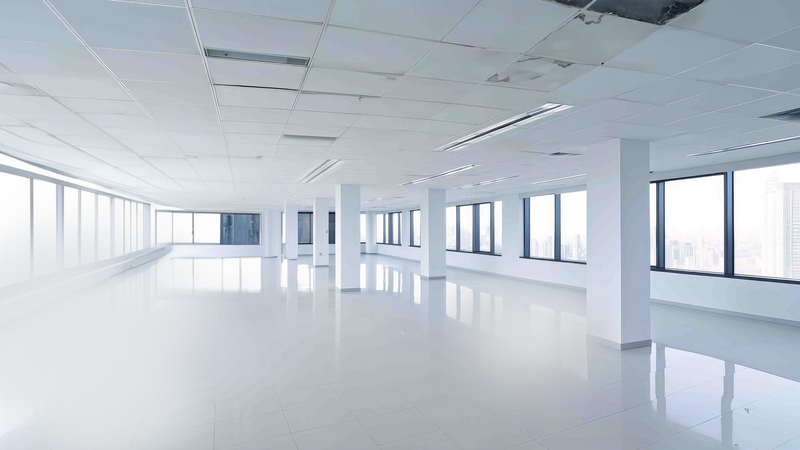Commercial buildings require regular maintenance to remain in working condition. In many ways, buildings are like living entities, ebbing and flowing with environmental changes; differing climates and conditions can also affect the way buildings change.
When spaces go vacant and don’t have people interacting with them regularly, those buildings can begin to deteriorate and require costly repairs. If a commercial space faces extended vacancy, maintaining that space is essential to protect the investment and ensure it’s ready for the next tenant.
Shifts in Climate Can Cause Major Damage
A consistent climate is key for any structure. Major shifts in temperature can cause damage in numerous parts of a building. For example, in cold climates, steep temperature drops can cause pipes to freeze. In extreme cases, if that temperature shifts up and down repetitively, the continuous expansion and contraction can lead to burst pipes and flood damage.
Although reducing temperature in vacant space during the winter or letting temperatures rise in summer can be a reasonable, cost-saving option, it’s important to have people in the building regularly to ensure the temperature doesn’t drop below a certain threshold. In addition, keeping up on preventative and predictive maintenance are imperative to ensure assets continue to operate properly.
Environmental Factors Can Cost Big
Most places experience environmental conditions like rain and moisture, which can wreak havoc on structures. Factors like direct sunlight, shade cover, or air quality can even impact a building’s condition. Roofs and sheathing protect the building from water penetration and should be regularly inspected for leaks. Fixing leaks in a building’s roof is much more cost effective than replacing entire exteriors. Sealing exterior cracks in a building’s sheathing or roof also makes the space more energy efficient, improving sustainability while protecting investments.
This is why it’s critical to have people in your vacant space regularly to raise the alarm if any leaks are observed. A facilities management provider can help monitor commercial spaces by sending technicians to regularly perform maintenance.
Unkept Space Leaves Buildings Vulnerable
Keeping commercial space clean is paramount to ensuring it’s ready for the next tenant. Though owners and occupiers may have fewer cleaning and maintenance needs in a vacant space, it’s still important to keep up on regular services to ensure dirt and debris don’t cause long-term damage. When facilities are left uncleaned for extended periods, mold and bacteria can form, making for unpleasant conditions that can be costly to remedy.
Specialized surfaces like windows, stone, and hardwoods can also be damaged without regular upkeep, which can lead to expensive replacements that also compromise the sustainable environmental and financial nature of the investment in these materials. Along with specialized surfaces, facility technicians should always look out for metal corrosion, as it can be destructive to commercial buildings. If corrosion is noted, protective coatings or other repairs should be made immediately.
Exterior Upkeep Like Landscaping and Snow Removal
Keeping up the exterior of a building is as important as maintaining the interior. As we discussed in the section on environmental factors, building roofs and sheathing must remain in good condition to protect assets and interior spaces.
Keeping up with landscaping, snow removal, and other groundwork is an important part of maintaining a vacant commercial property. Well-maintained grounds keep property appealing and attractive to facility users or potential tenants. But groundskeeping isn’t just for aesthetics—overgrown landscaping and uncut grass can attract and harbor pests. Overgrown shrubs or flower beds brimming with weeds may invite rats or other rodents into the building.
Another thing to consider in cold climates is keeping up with snow removal. Not only does a plowed entry bring curb appeal to commercial property, but also keeps the space accessible. If an unexpected fire breaks out or a boiler shuts down on a cold day, it’s critical that emergency services or technicians can enter the building.
Heightened Risk of Vandalism and Damage to Assets
When buildings appear vacant, there is an increased risk of attracting crime like vandalism, theft, or arson. This not only affects the viability of the property for future use, but also disrupts communities. In Austin, Texas, a study found that “blocks with unsecured [vacant] buildings had 3.2 times as many drug calls to police, 1.8 times as many theft calls, and twice the number of violent calls” as blocks without vacant buildings.
According to Strategic Fire: “more than 12,000 fires break out in vacant structures each year in the US, resulting in $73 million in property damage annually. Most are the result of arson.” Keeping buildings secure and maintaining fire suppression systems when vacant are important parts of protecting these investments.

